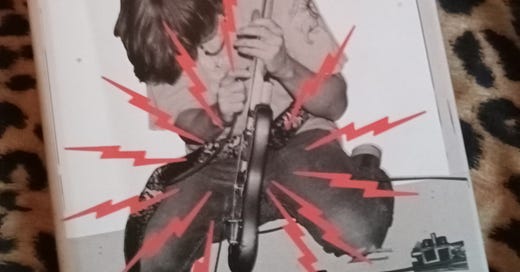Reading Is Fundamental: Thurston Moore’s Sonic Life is 470 pages of sonic truth.
Sometimes, the most important lessons are learned in the feedback loop of chaos—and this one comes with a fallout-fueled subscription special.
Thurston Joseph Michael Moore, of London-by-way-of-Northhampton, Massachusettes-by-way-of-NYC-by-way-of-Bethel, Connecticut-by-way-of-Coral-Gabels, Florida, is my type of musicologist. As related in his recent book, Sonic Life: A Memoir [470 pages, $35, Doubleday, New York, 2023], his rock ‘n’ roll impulses were first awakened by The Kingsmen’s garage apotheosis “Louie Louie.” Meaning he was a punk rocker from the moment he saw the checkered flag drop.
In high school, he was inducted into the same dirtbag metal culture as every American teenager since Mark Farner bought his first Marshalls. Except he preferred Alice Cooper’s horror glam and The Stooges’ completely unfiltered power rock. He soaked up every word in Creem and Rock Scene, spending many a weekend driving down to NYC from Connecticut with his pal Harold Paris. Fueled by Coca Cola and their earliest drug experiments, the high school seniors absorbed crucial bands like The Cramps and Suicide at CBGB and Max’s, following interminable commutes in an old Volkswagen. After returning home, they’d pester the local record stores to stock the flood of new punk records seemingly released weekly by that point.
Yearning for New York’s filthy streets, he finally relocates there. Then it's headfirst into the East Village, a grimy, vibrant landscape where art and music collided in a glorious mess. He writes of CBGB, a haven for misfits and sonic terrorists, of his first band The Coachmen, of No Wave and the downtown art scene and the eventual birth of Sonic Youth, a band that was equal parts art project and noise bomb.
Yes, Sonic Youth's story – the noise, the fury, the Kim Gordon scowl that launched a thousand feminist fanzines – is etched deep into alterna-rock’s DNA. But Sonic Life is hardly just about the band. It’s not a rehash of old gig flyers and backstage brawls. It's about the philosophy behind the music. It's about improvisation, about embracing the unpredictable, about finding beauty in the dissonance. Moore waxes poetic about John Cage and Sun Ra, about Glenn Branca and tuning systems and the secret language of feedback. He dives deep into the DIY ethos, the punk spirit that fueled their early days, the belief that anyone can make art, even if it sounds like a blender full of broken glass. This is a deep dive into the soul of an artist who lived and breathed sonic exploration like a junkie needs his fix.
His accounts of crucial gigs he witnessed puts you right there, seated at Max’s as Alan Vega’s coming at you. He writes intimately of his day-to-day life, struggling with crap jobs to fund his art, even writing about food that sustained him! (There’s an entire chapter about knishes, ferchrissakes!) He ain't shy about the dark corners, either. The break-up of Sonic Youth, the turmoil of personal relationships, the struggles of navigating the music industry's meat grinder. He lays it bare, imperfections fully displayed, but always with a sense of honesty and self-deprecating humor. This is no self-aggrandizing rockstar jeremiad. It's a human story, messy and real, told by someone who's seen the shadowed realm behind everything and still comes back humming gorgeous melodies.
This is the true power of Sonic Life. It's a love letter to the transformative power of music, a testament to the creative spirit that can't be contained by genre or convention. It's a reminder that even the most discordant noise can hold beauty, and that sometimes the most important lessons are learned in the feedback loop of chaos.
So, if you're looking for a music bio that's equal parts heady and heart-wrenching, a book that will leave your ears ringing and your mind buzzing, then Sonic Life’s your literary tonic. It's a book for the misfits and the dreamers, for the headbangers and the noisemakers, for anyone who's ever dared to turn the volume up to eleven and let the world burn. Just remember, kids, don't blame me if your neighbors call the cops after you crank this one up!
Standing By Kamala and Punk Integrity
Dear Reader, let me start with a thank you. The responses to yesterday’s endorsement of Kamala Harris have ranged from supportive to unsubscribing – ten readers, in fact, including one paying subscriber. That’s no small hit, given this month’s dip in hours at The Day Job and the $109.25 in lost Substack revenue over the month, due to taking a political stance. And yet, I don’t regret it. Punk journalism is about authenticity, and if some readers don’t resonate with boldly stating my ideas, then perhaps this isn’t their corner.
I’m nevertheless heartened to report that ten new subscribers joined us yesterday, standing by my principles – a true testament to the power of community.
It’s also a reminder that the voices supporting the punk ethos need you. With rent due and little room for luxuries like gear or even groceries, and losing that $109.25, I’m launching a November Subscription Special. Right now, you can take 20% off new or upgraded subscriptions (for life!) – your support goes directly toward fueling the raw, principled journalism you’ve enjoyed here. Thanks for being here, and for giving two or more good fucks about what matters (to paraphrase the loudest of my detractors).
#TimNapalmStegall #TimNapalmStegallSubstack #PunkJournalism #BookReview #ThurstonMoore #SonicLife #SonicYouth #PunkPhilosophy #NoiseRock #DIYMusic #FeedbackLoop #ArtAndChaos #NYCUnderground #SonicTruth #CBGBMemories #NoWave #MusicMemoir #CreativeRebellion #UnfilteredRock #LifeLessons #Substack #UndergroundMusic #PunkInfluence #DIYCulture #SupportIndependentMedia #NapalmNation #Subscribe #20percentoff #Monthly #Annually #ForLife #UpgradeYourFreeSubscription #BestWayToSupport




That dude is an example of ‘love the art, not the artist’.